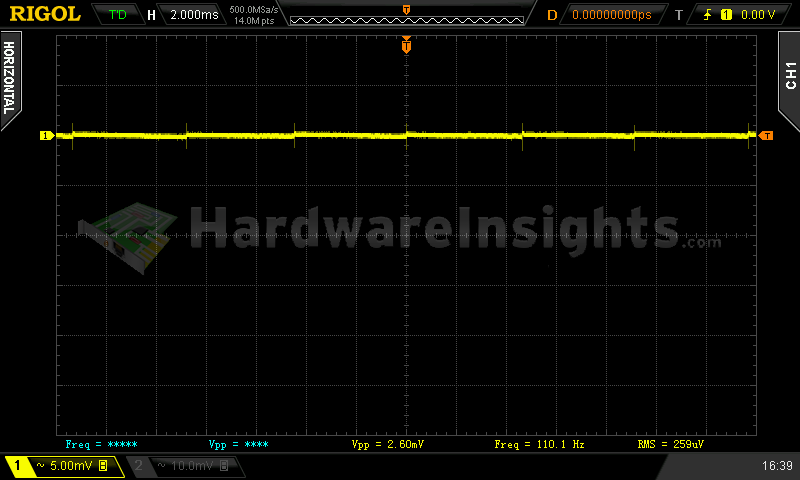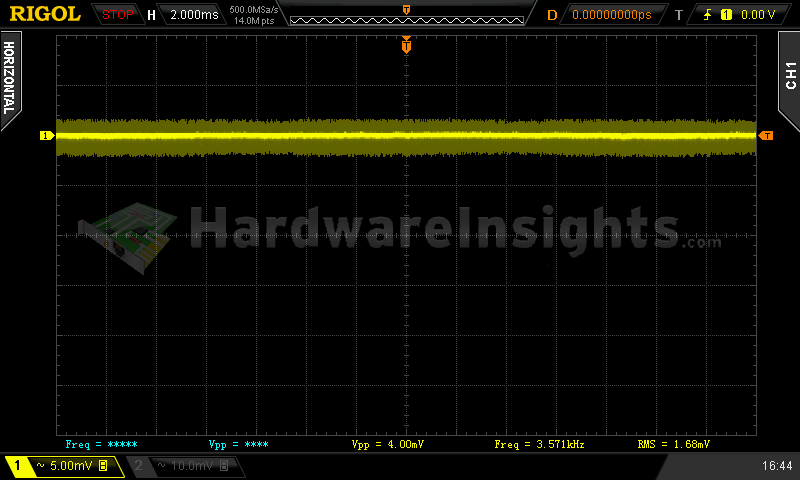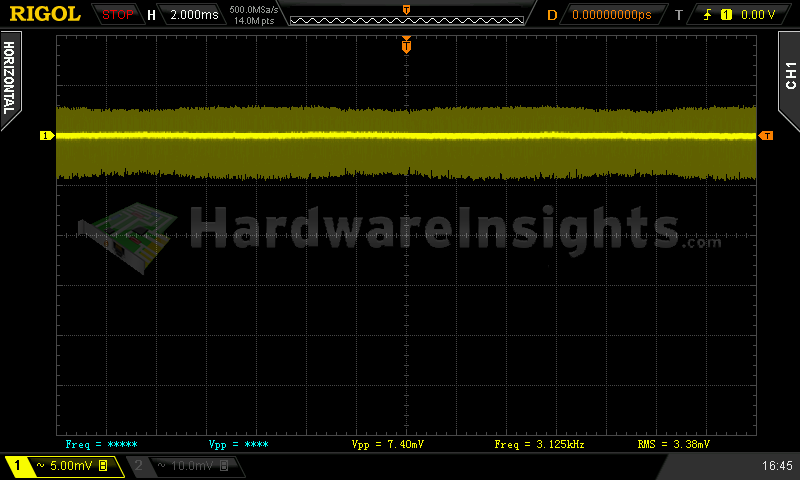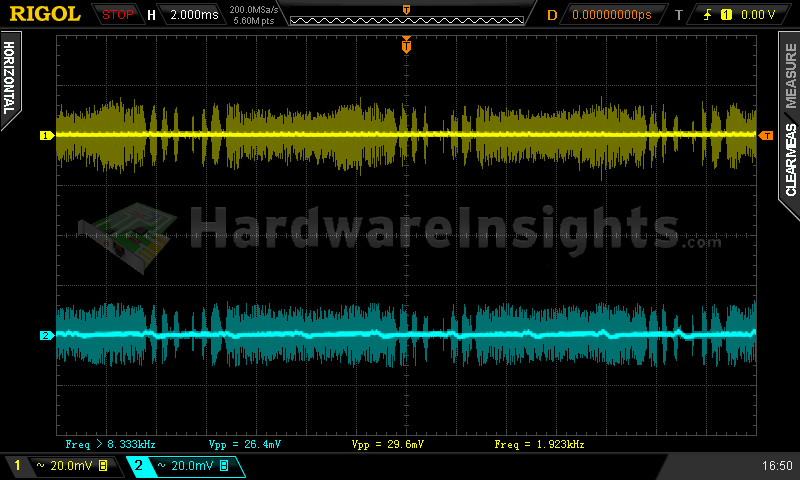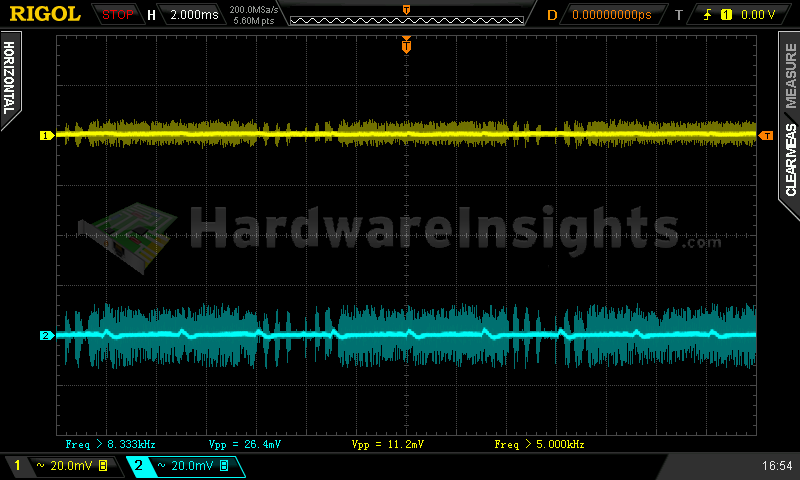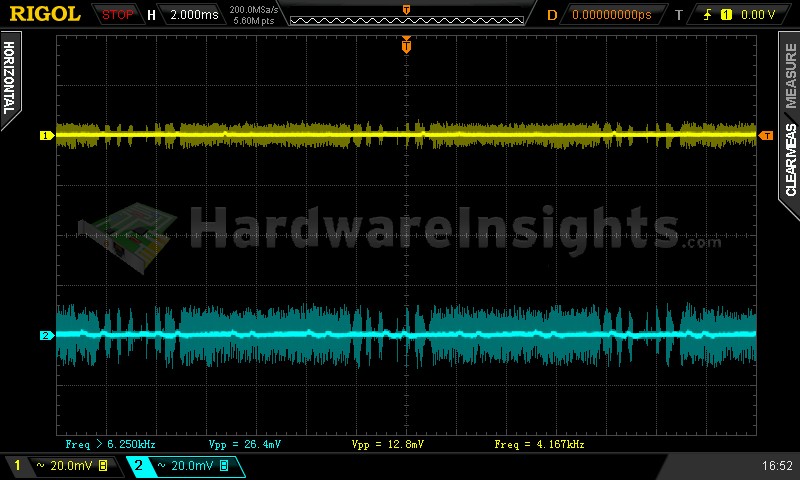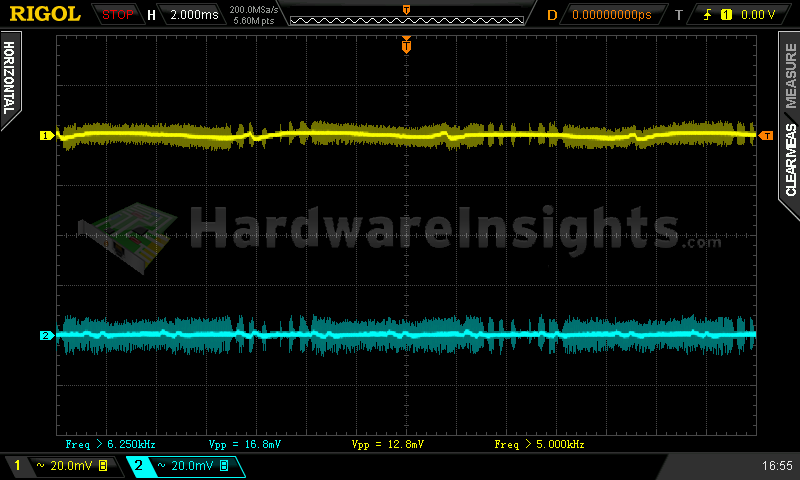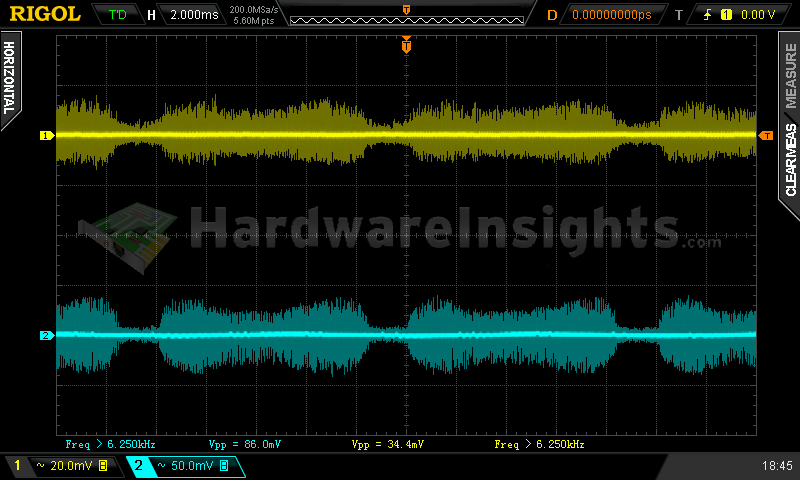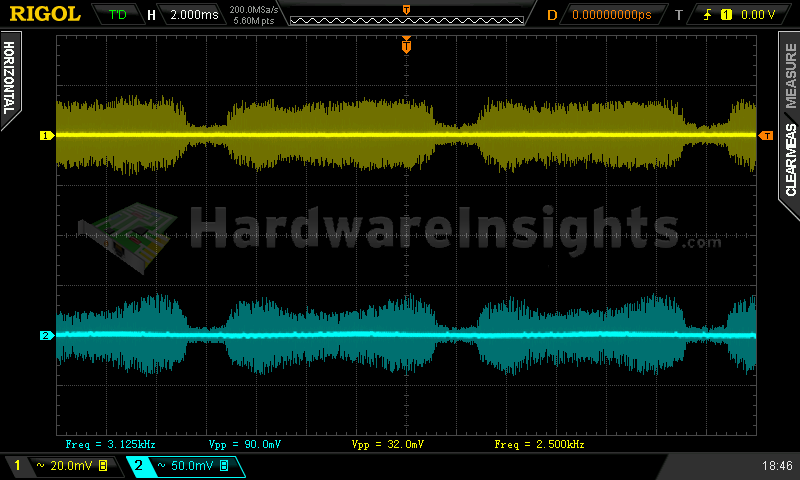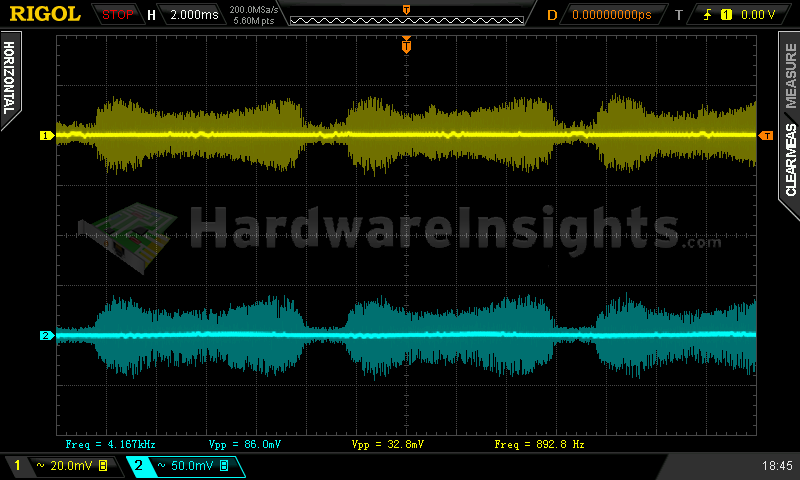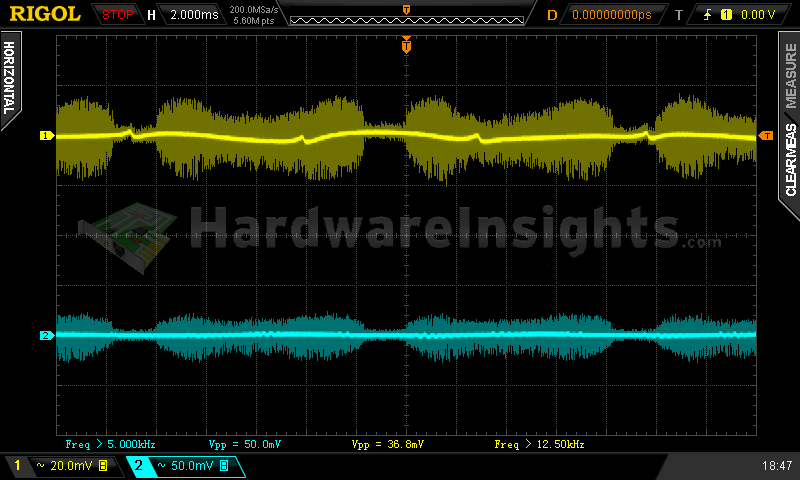Contents
- 1Introduction
- 1.1Packaging and accesories
- 2Connectors & cabling
- 2.1Casing & cooling
- 3Input filtering
- 4Primary side
- 4.1+5 V stand-by rail
- 5Secondary side
- 5.1Build quality
- 6Load testing
- 6.1Loading +5 V SB
- 6.2Combined loading
- 6.3Combined loading ripple
- 6.4Crossloading, overloading
- 6.5Crossloading, overloading ripple
- 7Conclusion and evaluation
- 7.1Thanks
Load testing
Loading +5 V SB
As always, all load testing is done in accordance with testing methodology. The stand-by supply in Seasonic S12G 550 W had no problem providing both nominal power and extra power under (short) overload scenario. The efficiency was quite good, reaching 80 %. Voltage started somewhat above nominal and dropped slightly below by the end. Ripple was somewhat higher than usual, especially under overload.
| Output (W) | Load (A) | Voltage (V)/ ripple (mV) | Input (W) | Efficiency/power factor |
| 0 | 0 | 5.06/2.60 | 0.5 | —/1 |
| 12.08 | 2.42 | 4.99/4.00 | 15.5 | 77.9 %/0.47 |
| 16.57 | 3.34 | 4.97/7.40 | 21.0 | 78.9 %/0.48 |
+5 V SB ripple (left to right): 0 A; 2.42 A; 3.34 A
Combined loading
Combined loading also went without major incidents. I have not even tried to run this unit with approx. 0.3A load on −12 V rail as in all previous cases the OCP was set too tightly and using fan on this rail always meant immediate shutdown. Efficiency for this unit was hitting 93 %, but still did not reach 90 % even with load over 100 W so this 550W version is definitely not suitable for sub-100 watt loading if you are concerned with efficiency.
| Output power | Load/ voltage +5 V SB | Load/ voltage +3.3 V | Load/ voltage +5 V | Load/ voltage +12 V | Load/ voltage −12 V | Input power | Efficiency/power factor | Temperature intake/ outtake |
| 5.1 %/ 27.81 W | 0 A/ 5.05 V | 0.018 A/ 3.37 V | 0.248 A/ 5.04 V | 1.973 A/ 12.21 V | 0.215 A/ −11.21 V | 37.0 W | 75.2 %/ 0.79 | 26 °C/ 28 °C |
| 20 %/ 116.69 W | 0.493 A/ 5.03 V | 1.517 A/ 3.36 V | 2.174 A/ 5.04 V | 7.84 A/ 12.20 V | 0.222 A/ −11.33 V | 130.0 W | 89.8 %/ 0.98 | 26 °C/ 29 °C |
| 40 %/ 239.76 W | 0.981 A/ 5.00 V | 2.91 A/ 3.35 V | 3.32 A/ 5.03 V | 16.9 A/ 12.18 V | 0.222 A/ −11.53 V | 258.5 W | 92.8 %/ 1 | 27°C/ 32 °C |
| 60 %/ 325.21 W | 1.44 A/ 4.98 V | 4.15 A/ 3.35 V | 4.83 A/ 5.03 V | 22.8 A/ 12.16 V | 0.221 A/ −11.72 V | 351.0 W | 92.7 %/ 1 | 27 °C/ 35 °C |
|
80 %/ 443.36 W |
1.91 A/ 4.96 V | 4.52 A/ 3.34 V | 5.98 A/ 5.02 V | 31.8 A/ 12.14 V | 0.229 A/ −11.95 V | 484.5 W | 91.5 %/ 1 | 27 °C/ 33 °C |
| 100 %/ 548.43 W | 2.35 A/ 4.94 V | 5.89 A/ 3.33 V | 7.83 A/ 5.02 V | 39.2 A/ 12.12 V | 0.229 A/ −12.22 V | 605.0 W | 90.7 %/ 1 | 27 °C/ 36 °C |
Around 400 watt the unit’s fan became audible even with loader fans running, that is also probably why the outtake temperature dropped a little bit. As usual with these Seasonic platforms, voltages started a little higher and decreased with load, with +3.3V rail starting at 3.37 V, that is more than 2 % over nominal value, and the −12 V rail starts at −11.21 V, that is over 6.5 % less than nominal. While actually having feedback wires from all major rails, this is definitely not a problem of voltage regulation rather than deliberate setting. Seasonic definitely could achieve tighter regulation without any effort. My opinion is this is intentional to achieve higher efficiency. There will be some small loss of points here anyway, no matter the reason, this is deviation from nominal value.
Combined loading ripple
Another usual symptom of these platforms is high interference. One of the reasons may be omitted Y capacitor on primary side, between PSU ground and earth ground. Anyway, I constantly have headaches with search for the right spot where the interference is not affecting oscilloscope probes as depending on their position, the ripple results vary as much as 100 % and can easily go well over ATX specification. In my opinion, this is another flaw of this design, no other high-end units than Seasonic showed this behaviour so far.
| Output % | Ripple +5 V SB | Ripple +3.3 V | Ripple +5 V | Ripple +12 V | Ripple −12 V |
| 5.1 | 29.6 mV | 11.2 mV | 12.8 mV | 26.4 mV | 12.8 mV |
| 20 | 21.6 mV | 9.6 mV | 13.6 mV | 36 mV | 12.8 mV |
| 40 | 27.2 mV | 22.4 mV | 34.4 mV | 78 mV | 24.8 mV |
| 60 | 28.8 mV | 37.6 mV | 27.2 mV | 70 mV | 31.2 mV |
| 80 | 28.0 mV | 30.0 mV | 30.4 mV | 80 mV | 39.6 mV |
| 100 | 34.4 mV | 32.0 mV | 32.8 mV | 90 mV | 36.8 mV |
The ripple values jumped after approx. 30 % load when the driving circuitry went into different switching state (there are up to three different switching states with modern SMPS controllers). It is clearly visible on the O-scope screenshots. All in all, a result of 90 mV on +12 V rail is very poor for a high-end unit.
Ripple 5.1% load (left to right): +5 V SB; +3.3 V; +5 V; −12 V. The second channel is connected to +12 V.
Ripple 100% load (left to right): +5 V SB; +3.3 V; +5 V; −12 V. The second channel is connected to +12 V.
Crossloading, overloading
Crossloading went quite well, considering this is +12V unit with DC-DC modules, I did not expect anything else. Voltage regulation was somewhat tighter and squeezed into 2% difference for +3.3 V, but was still more than 4 % off for −12 V rail. Efficiency in the case of +12V load was very good, well over 90 %. With +5V loading it dropped down to 88 % and with +3.3V loading it dropped further to 84 %. OCP for +5 V rail kicked in past 27.3 A, for +3.3 V I did not reach the neccessary load. OTP did not react as even with fan grille fully blocked by a sheet of paper, the unit was capable of cooling itself.
| Output power | Load/ voltage +5 V SB | Load/ voltage +3.3 V | Load/ voltage +5 V | Load/ voltage +12 V | Load/ voltage −12 V | Input power | Efficiency/power factor | Temperature intake/ outtake |
| 98 %/ 543.5 W | 0.486 A/ 5.00 V | 1.504 A/ 3.35 V | 1.456 A/ 5.02 V | 43.3 A/ 12.12 V | 0.222 A/ −12.20 V | 593.5 W | 91.4 %/ 1 | 27 °C/ 37 °C |
| 24 %/ 132.21 W | 0.485 A/ 5.02 V | 1.523 A/ 3.36 V | 19.63 A/ 5.02 V | 1.941 A/ 12.21 V | 0.211 A/ −11.41 V | 150.0 W | 88.1 %/ 0.98 | 26 °C/ 32 °C |
| 20 %/ 108.75 W | 0.490 A/ 5.02 V | 20.22 A/ 3.35 V | 1.450 A/ 5.04 V | 1.961 A/ 12.21 V | 0.214 A/ −11.37 V | 123.5 W | 84.1 %/ 0.99 | 26 °C/ 31 °C |
| 152 %/ 684.83 W | 3.22 A/ 4.90 V | 16.94 A/ 3.32 V | 12.30 A/ 5.00 V | 45.2 A/ 12.10 V | 0.235 A/ −12.54 V | 772.5 W | 88.5 %/ 1 | 26 °C/ 36 °C |
Combined overloading is completely different story. This time I tried a different approach. Load on all rails but +12 V was set slightly over nominal value. Than I started increasing load on this rail also, somewhat faster with increase of several amps every 20-30 seconds. This simulates workstation with high load on +3.3/+5 V (e. g. many hard drives and add-in cards) with increasing load on +12 V (e. g. computational task with increasing load on CPU/GPU cores). Slightly over 50 % overload, I noticed huge drops on +12 V rail on oscilloscope, definitely the unit was near its limit. Finally, the voltage on +12 V rail dropped under nominal value and kept dropping in real time, a few seconds later the unit shut down and I have not been able to turn it on again since then.
I have just witnessed the usual way of diode rectifier terminal overheat and shorting. Once again the SBR10U45 rectifier in Seasonic’s semi-synchronous rectification burned. I have experimented with this subject in the Antec TP-550C I reviewed at the end of last year, which also burned (together with SSR-550RM). Using STPS15L60CB rectifiers instead of SBR10U45, the unit was finally able to turn off gracefully under multiple overload scenarios. The OPP is clearly set higher than the SBR10U45 can handle. Seasonic is working to address this issue, the solution is already set, however, I cannot comment more on this subject before it is launched in next batch of products.
Crossloading, overloading ripple
Full load on the +12 V rail increased its ripple even more, to 94 mV. With lower load on +3.3/+5 V rails, it decreased back to more reasonable values. During final stages of the combined overload, the values went through the roof, much higher than the 43.2 and 80 mV in the table and completely out of spec.
| Output % | Ripple +5 V SB | Ripple +3.3 V | Ripple +5 V | Ripple +12 V | Ripple −12 V |
| 98 | 27.2 mV | 36.8 mV | 25.6 mV | 94 mV | 39.2 mV |
| 24 | 13.6 mV | 11.2 mV | 16.8 mV | 42 mV | 15.2 mV |
| 20 | 16.0 mV | 10.4 mV | 17.6 mV | 28 mV | 8.0 mV |
| 152 | — | — | 43.2(+) mV | 80(+) mV | — |
